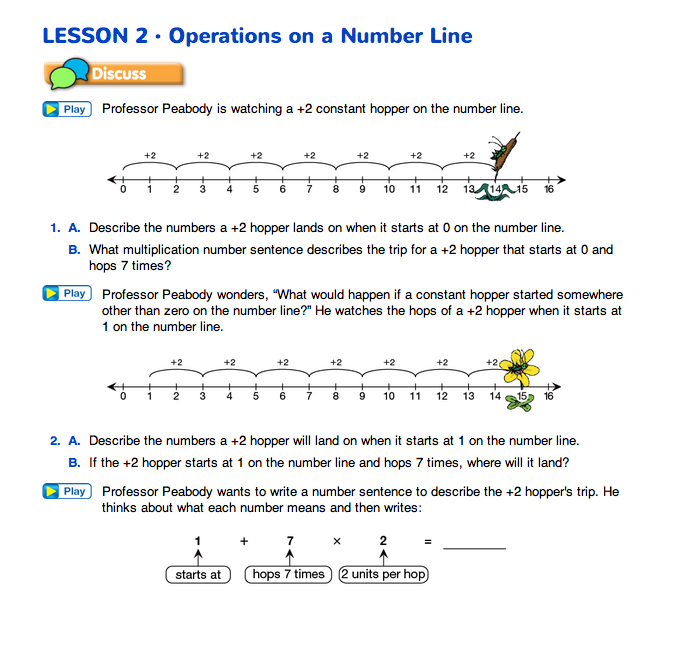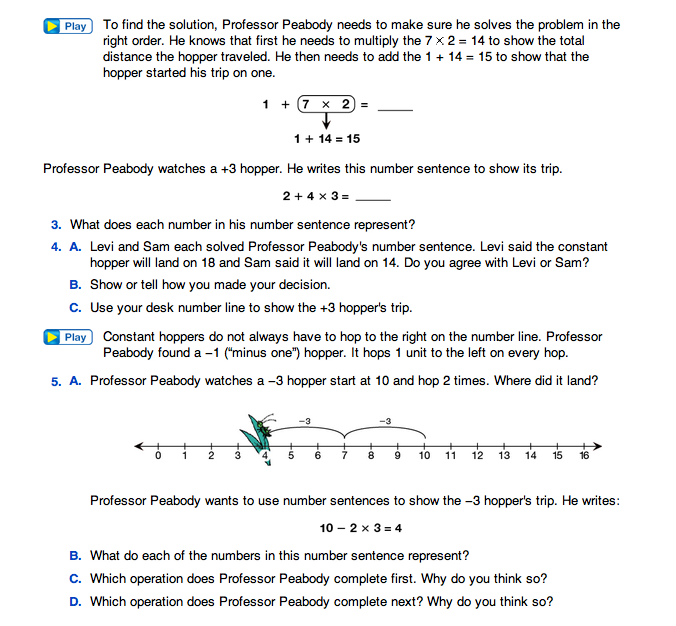Use a Number Line to Represent Multiplication. Students were introduced to constant hoppers in Unit 8 Lesson 2. Remind students that constant hoppers are math hoppers that always hop a consistent number of units. This means the distance of each hop stays the same.
Use the class number line and the discussion prompts to review constant hoppers. Ask one student to show the movements the constant hopper will make on the class number line while another student records a number sentence to describe the constant hopper's trip. The other students in the class can use their desk number lines to solve each problem.
- A +3 hopper starts at 0 and hops 4 times. Where will it stop? (12)
- What are two number sentences that can be used to describe its trip? (3 × 4 = 12 and 3 + 3 + 3 + 3 = 12)
- What does each number in the multiplication sentences represent? (The number 3 tells the size of each hop. The number 4 is the number of hops and the number 12 is where the hopper stopped.)
- What do the numbers in the addition number sentence represent? (Each of the 3s represents a hop on the number line. There are four of them so there were four hops. The number 12 is where the hopper lands after all the hops.)
- A +5 hopper starts at 0 and hops until it lands on 30. How many hops does it make? (6)
- What multiplication number sentence can you write to describe its trip? (5 × 6 = 30)
- How did you use the number line to find the number of hops? (Possible response: Since I knew the size of each hop, I started on 0 and then counted the number of +5 hops I made to land on 30.)
- A constant hopper begins at 0 and hops 3 times before landing on 18. How big were its hops?
(6 units)
- What strategy did you use to decide? (Possible response: I though about what number times three is equal to 18 to find the 6.)
- Did anyone else use a different strategy? (Possible response: I used my number line. I started on 18 and hopped back 3 each time until I reached 0. I hopped 6 times. Since 6 hops of 3 will reach 18, 3 hops of 6 will also reach 18.)
Provide additional problems for the students to solve using the class number line and their desk number lines if more practice is needed.
Explore Constant Hoppers That Do Not Start at Zero. Use the vignette and Questions 1–5 on the Operations on a Number Line pages in the Student Guide to introduce this part of the lesson. In this vignette Professor Peabody explores constant hoppers that start somewhere other than zero on the number line.
In Questions 1–2 students look at the numbers that a +2 hopper will land on if it starts at zero or one.
After students have had time to discuss these two questions with a partner or in a small group, ask:
- What do you notice about the numbers the +2 hopper lands on when it starts at 0? (Possible responses: It only lands on even numbers. These are the same numbers you use when you skip count by 2s. The numbers are all multiples of 2.)
- What happens to the pattern when the +2 hopper starts at 1? (Possible response: Now the numbers are all odd numbers.)
In the next short vignette, Professor Peabody introduces the number sentence 1 + 7 × 2 = 15 to describe the trip of a +2 hopper when it starts on 1 and hops 7 times. Professor Peabody emphasizes that he must first multiply the seven times two because this computation defines that the + 2 hopper traveled a distance of 14 units on the number line. He then adds one to this total to show that the hopper started at one on the number line. While this short vignette describes the algebraic order of operations in mathematics, it is not intended to be a formal introduction to order of operations.

Order of Operations. At first glance, an expression such as 5 + 4 × 3 is open to various interpretations. One approach takes 5 + 4 × 3 to mean, “First add 5 and 4 to get 9, and then multiply by 3 to obtain 27.” This simple left-to-right interpretation is the way many four-function calculators evaluate the expression, but it is incorrect, according to mathematical convention accepted the world over. The standard mathematical meaning of 5 + 4 × 3 is, “First multiply 4 times 3 to get 12, and then add 5 and 12 to get 17.” This interpretation is based on a convention known as the algebraic order of operations. This convention specifies the order in which operations in mathematical expressions are to be carried out:
- Do calculations in parentheses first.
- Do all multiplications and divisions in order from left to right.
- Then do all additions and subtractions in order from left to right.
For example, 48 ÷ 6 − 3 + 2 = 8 − 3 + 2 = 7.
Parentheses change the order, so 48 ÷ (6 − 3) × 2 = 48 ÷ 3 × 2 = 16 × 2 = 32
After reading and discussing this vignette ask students to complete Questions 3–5 with their partner or small group.
In Questions 3–4 students are given a number sentence that describes the trip of a +3 hopper. They first identify what each number represents and then solve the number sentence to find where the hopper will land.
Question 5 introduces students to minus constant hoppers. These constant hoppers hop to the left on the number line.
Before asking students to complete this question, ask:
- If a + constant hopper moves to the right on the number line, how would a − hopper move? (It would move to the left.)
Ask students to use their desk number lines to show how a minus constant hopper moves on the number line.
- Professor Peabody found a −1 hopper. If you have a −1 hopper that starts on 10 and hops 5 times where will it land? (It will land on 5.)
- What subtraction number sentence describes the trip of this number hopper? (10 − 1 − 1 − 1 − 1 − 1 = 5)
- What is another number sentence you could use to describe its trip? (10 − 5 × 1 = 5)
- In this number sentence, what does the 10 represent? (The 10 tells where the constant hopper starts on the number line.)
- What does the number 5 represent? (It tells how many hops the hopper made.)
- What does the number 1 represent? (It tells the size of the hops made by the constant hopper.)
- How does this number sentence tell you that you are going to move to the left on the number line? (You subtract the distance hopped instead of adding the distance hopped.)














